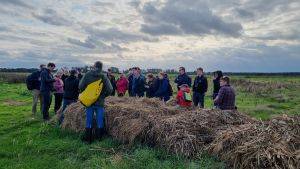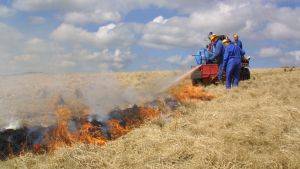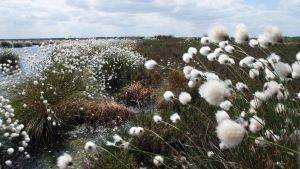Working to Benefit Wildlife and to Safeguard National Treasures
Introduction
Humberhead Peatlands National Nature Reserve is the largest area of lowland raised mire in England, representing 30% of the English resource with 2887 ha. Close to Doncaster in South Yorkshire, the reserve is managed by Natural England and the Lincolnshire Wildlife Trust. It sits within the Humberhead Levels, an area covering a now lost wetland landscape of the upper Humber.
Description
The Humberhead Peatlands, covering most of Thorne, Hatfield and Crowle Moors, are a meeting place for northern and southern species, resulting in a unique species mix. The site is designated as an SAC for its peatland habitats, and an SPA for its large population of breeding nightjars. It is also famous for its invertebrates, which include the Thorne pin-palp beetle and the mire pill-beetle, both found nowhere else in the UK, and the large heath butterfly. The total insect fauna recorded exceeds 5,500 species - around 25% of British fauna - with over 30 Red Data Book species and over 250 nationally scarce species. Over many centuries, peat has been lost through drainage, agricultural improvement and peat cutting, largely for fuel. From the 1880s the remaining core of deeper peatland was cut, initially to provide peat for horse litter, and subsequently for horticultural use. By 1994 the whole site had been partly cut or drained, and peat milling, which leaves a bare de-vegetated surface, had been carried out on about half the site.
Project Aims
Peatland restoration requires a long-term approach in fine tuning water level management for best results for wildlife and the peatland archive. In addition, the Humberhead Peatlands will provide further visitor access, volunteer opportunities and education programmes to promote enjoyment of the amazing landscape, the rich wildlife and human heritage.
Restoration Delivered
Restoration has proved highly successful over the majority of the reserve. Through the careful management of water levels, much of the milled land has re-vegetated, and the peatland archaeological archive is protected. At the same time, the number of nightjars has increased and the reserve has been colonised by breeding common cranes. The legacy of dry tracks created for peat extraction, as well as a substantial area of sand and gravels where peat was stripped prior to quarrying, now provides easy access for visitors.
Site Activity
As waterlogged soils, peat deposits provide a rich archive of cultural and environmental change. With over 100 archaeological sites from 8,500 years ago to the Roman period 400 AD, the Humberhead Levels preserved some of the oldest and most intriguing archaeological remains. This includes the oldest plank boats in the world, outside Egypt, a rare Bronze age pathway laid through Thorne Forest 3000 years ago, as well as delicate beetle wings. Restoration helps to safeguard these national treasures. Humberhead Levels Partnership was established in 2001, aiming to create an internationally renowned, unique wetland landscape, supporting thriving communities, economy, ecosystem services and wildlife. Restoration began in 1994 but only in 2002, when Defra bought out the remaining peat extraction rights for £17 million, did the majority of the peatlands come under restoration management. A system of bunds, with a network of sluices, was created on the milling fields, to create the right conditions for revegetation by cottongrasses and Sphagnum moss. Drainage ditches have been dammed and scrub is controlled by cutting and grazing with Hebridean sheep.
Project Name: Working to Benefit Wildlife and to Safeguard National Treasures
Organisation / Lead partner: Natural England
Location: Humberhead Peatland NNR, South Yorkshire
Approximate area covered: 2887 ha
Conservation Status: Site of Special Scientific Interest (SSSI), National Nature Reserves(NNR)
Predominately: Upland
Peat Habitats: Lowland raised bog
Project Type: Restoration










